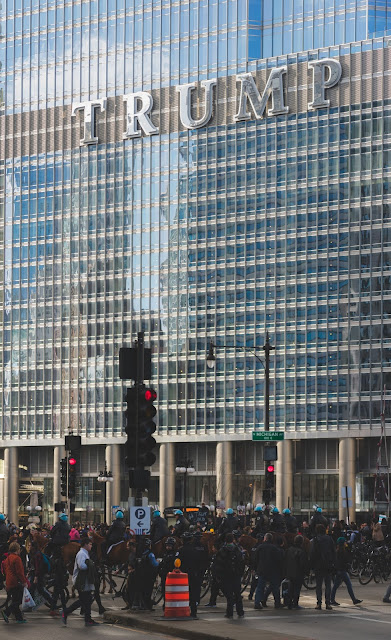Wobbles in the Trump Trades affect more than the Dollar ......
Wobbles in the Trump Trades affect more than the Dollar ......
re :- "The Biggest Risk From the Dollar's Drop May Not Be
What You Would Guess" , Bloomberg Markets
Confidence that the Trump administration is on course to deliver
on its electoral promises has been wearing a bit thin for a while now. If
anyone on the President's team was unaware of the difficulties of passing bold
(brash ?) campaign promises into law, the failure to get enough Congressional
support for Mr Trump's healthcare reforms must have illuminated even the most
blinkered of them.
Well, perhaps ..... although the official line is that frustrating
though the setback is, we'll just move on to other key issues such as slashing
cuts in personal and corporate taxation and boosting infrastructure spending.
Investors however, already nervous at the lack of detail emanating from the
administration, will be wondering where the money will be found for these
measures now that the President's plans for taking a knife to Obamacare have
been shelved. Allowing big increases in the budget deficit has been done before
by a Republican administration, but fundamentally goes against the GOP's
philosophy and Mr Trump may well run into serious opposition from within his
own party if that's the route he chooses to take.
On a more general level, the demise of the healthcare bill may
well cause investors to question just how much of his agenda the President will
be able get through Congress. After Mr Trump's remarkable electoral win in
early November, his pro-growth policies led to big upward moves in stocks, the
Dollar, and bond yields (and therefore lower bond prices). If equities have by
and large managed to hang onto most of their record-breaking gains, the action
in bond markets suggest that they are far from totally convinced that Mr Trump
will be able to bring off his promise of 3% - 4% growth. The yield on the US
10yr Treasury is back down to 2.37% from a high of 2.62%. As for the Dollar
..... yesterday's post-healthcare fiasco low of 98.85 on the Dollar Index is
nearly 5% off it's Jan 3rd highs.
And it's the Dollar that this Bloomberg article focuses on
..... or rather, the dangers faced by those trying to avoid it, scared off by
the potential losses presented by its unpredictable moves and by the obvious
policy confusion. We're talking about our old friend the Carry Trade here, a
popular and sizeable slice of the Foreign Exchange market but one not without
it's own risk. You know the principle of carry trades well : borrow in a low
rate currency, and convert into another currency to lend at a much higher rate.
Simple enough, although the danger is that when you come to close out the
trade, if your funding currency has appreciated in value against the higher
rate alternative, then your Foreign Exchange losses may wipe out or exceed what
you've made on the interest rate differential.
With its ultra low/negative rate regime, the Japanese Yen is the
archetypal (and most popular) funding currency, and the star performer in the
Carry Trade league table this year has been Long Mexican Peso / Short Jap Yen.
In a close to ideal scenario, currency moves have worked in favour of the carry
trader alongside the interest rate differential -- after all the
Peso bashing at the time of the US election and just after, the Mexican unit
has appreciated this year, even against the Yen, as short Peso positions have
been unwound in recognition of the emerging market rally, and of the fact that
Mr Trump's rhetoric may not be matched by actions.
In general though, the Yen has been strong -- not good
news for those shorting it to indulge in the carry trade. It seems that even if
it was your intention to steer clear of the Dollar and the uncertainties over
Mr Trump's policies, they can still come back to bite you. More than any other
currency in the world, the Yen is the "safe-haven" bolthole of choice
in times of uncertainty. So with that uncertainty surrounding the Dollar and
the Yen's safe-haven status, it's should be no surprise to learn that according
to Bloomberg the worst performing carry trade this year with the Yen as
the funding currency is ..... Long USD / Short JPY, with a return of -5.10%.
Top of that list of 16 major currencies against the Yen is of
course Long Mex Peso (MXN) / Short JPY at +5.42%, but most interestingly in
second place is Long S. African Rand (ZAR) / Short JPY at +3.40% --
the Rand also benefitting from short-covering and the emerging market /
commodities rally. The trouble is, the list was compiled yesterday morning and
that was before S. African President Zuma recalled Finance Minister Pravin
Gordhan from a trip to London and the US, and told the SA Communist party that
he intended to sack him. To do so would surely be another decisive step in the
destruction of the S. African leadership's credibility, both political and
economic, and the Rand has fallen by 4% as an immediate reaction.
Which just goes to show that there are many things that can affect
your carry trading, even if right now everything seems a little Trump-centric.



No comments